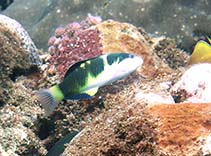| Family: |
Labridae (Wrasses), subfamily: Corinae |
| Max. size: |
20 cm SL (male/unsexed) |
| Environment: |
reef-associated; marine; depth range 0 - 15 m |
| Distribution: |
Western Pacific. |
| Diagnosis: |
Dorsal spines (total): 8-8; Dorsal soft rays (total): 13-13; Anal spines: 3-3; Anal soft rays: 11-11; Vertebrae: 25-25. Diagnosis: Dorsal rays VIII,13. Anal rays III,11, the first spine, when detectable is very slender and short. Pectoral rays 15-16 (usually 15). Lateral line scales 26-27. Head naked, except for a small patch of scales dorsally on opercle. Gill rakers 20-23. Body depth 5.9-3.6 in SL; head length (HL) 3.1-3.4 in SL; snout length 8.4-9.8 in SL; caudal peduncle depth 6.2-6.65 in SL; pectoral fins 4.0-4.3 in SL; pelvic fins 6.3-6.9 in SL. The caudal fin is truncate in young individuals, becoming strongly lunate with filamentous lobes in adult males. The initial phase is white with postorbital head and anterior body above pectoral-fin base black with an oblique yellow band above dorsal edge of opercle, a black bar over last 4 or 5 dorsal spines continuing ventrally across body, its posterior edge vertical, and a broader black bar over last 9 soft rays of dorsal fin, across the body, and posterior anal fin; a black spot on first 2 membranes of dorsal fin; the terminal males with yellow partly replacing the white, a salmon pink patch on chin, and blue ventrally on head and chest (Ref. 57555). |
| Biology: |
Found solitary or in groups, most commonly on outer reef areas, and also found in coastal reefs, lagoons and tide pools (Ref. 57555, 90102). |
| IUCN Red List Status: |
Least Concern (LC); Date assessed: 09 March 2009 Ref. (130435)
|
| Threat to humans: |
harmless |
Source and more info: www.fishbase.org. For personal, classroom, and other internal use only. Not for publication.
